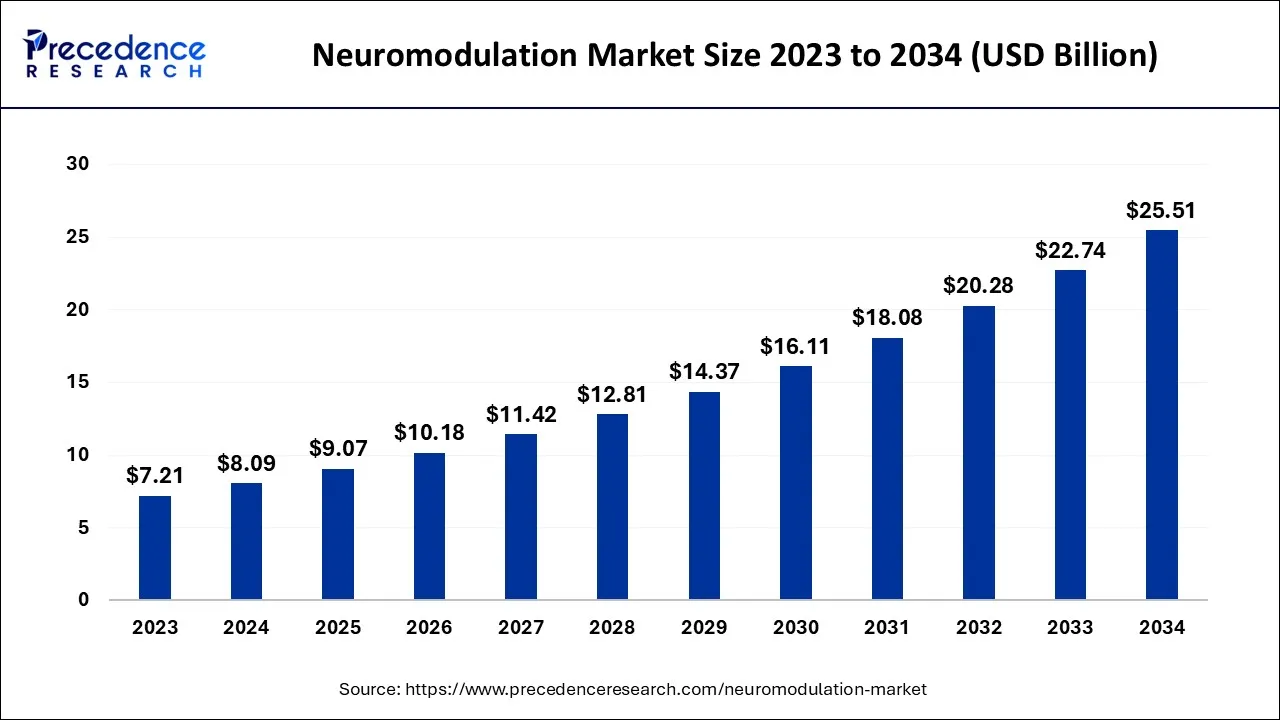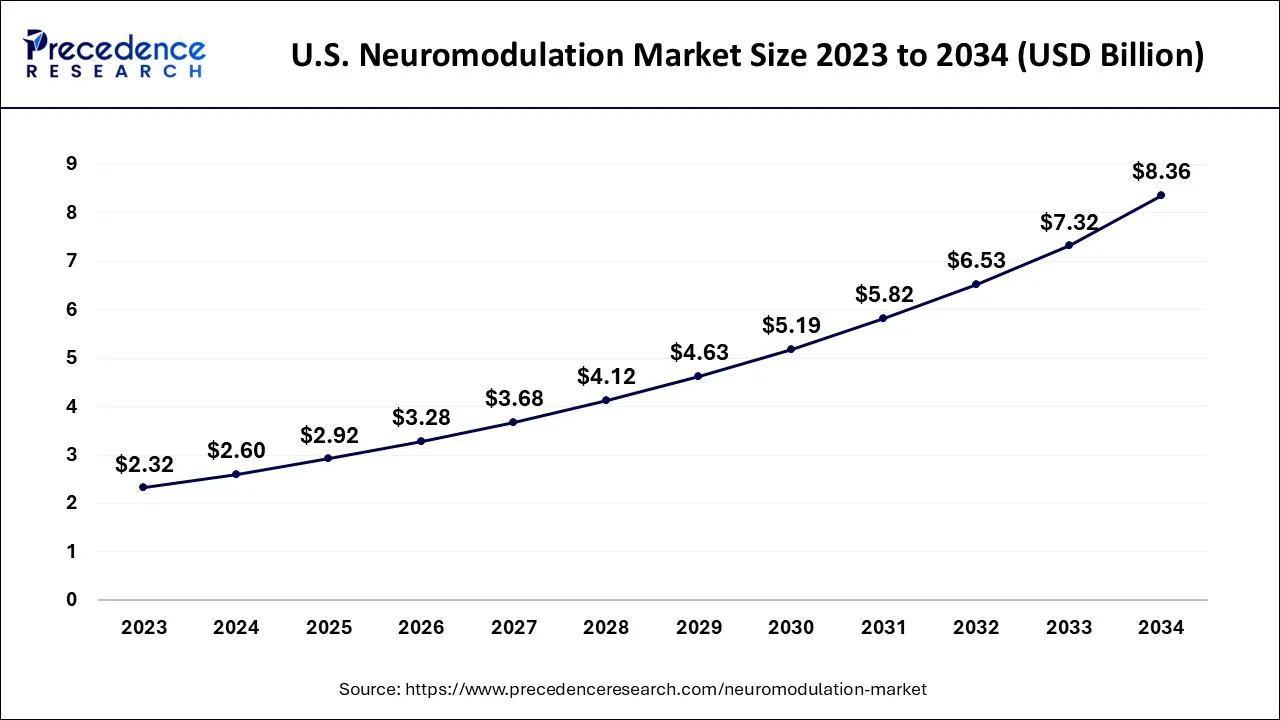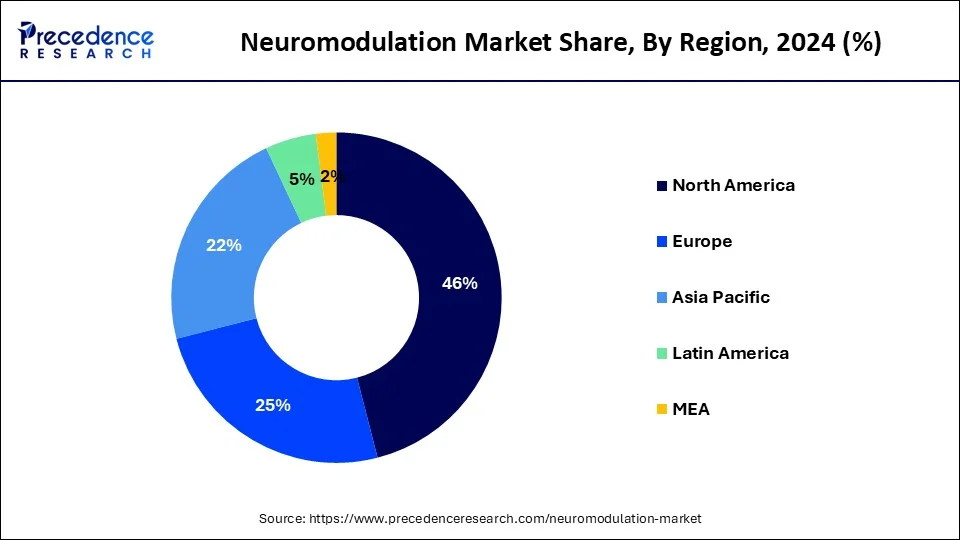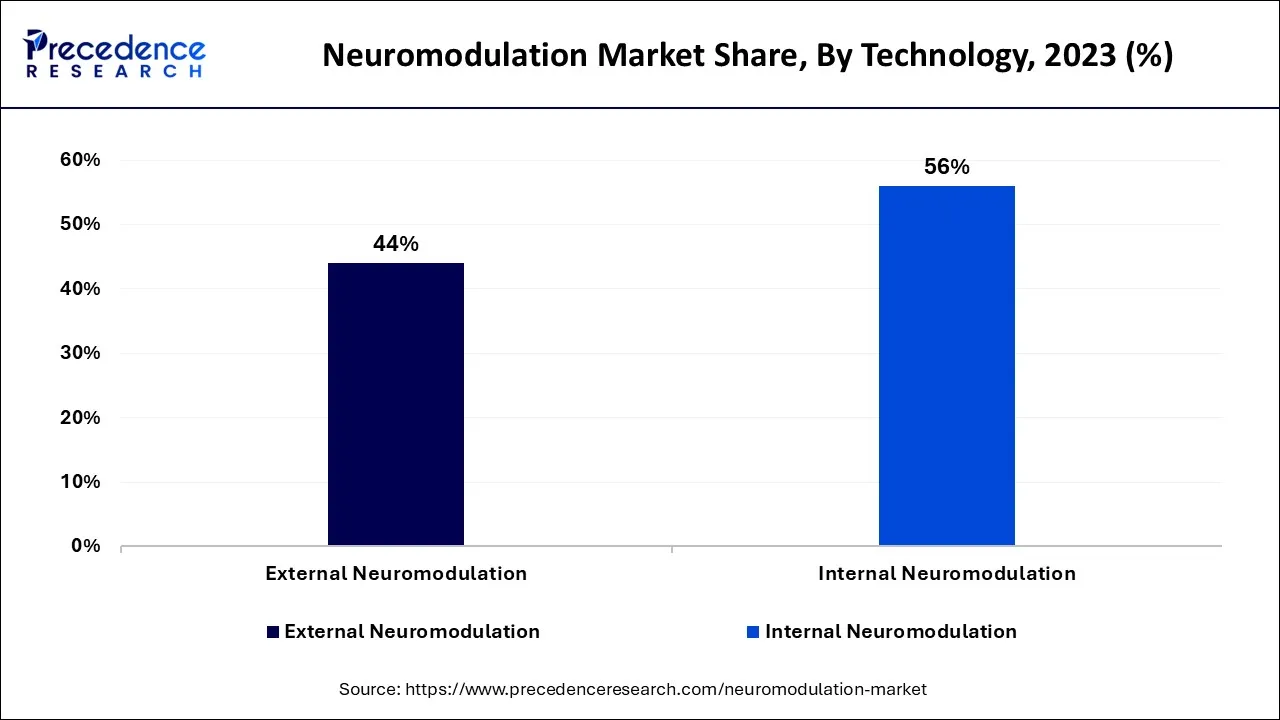The global neuromodulation market size accounted for USD 8.09 billion in 2024, grew to USD 9.07 billion in 2025 and is expected to be worth around USD 25.51 billion by 2034, registering a CAGR of 12.17% between 2024 and 2034. The North America neuromodulation market size is calculated at USD 3.72 billion in 2024 and is estimated to grow at a CAGR of 12.29% during the forecast period.
The global neuromodulation market size is calculated at USD 8.09 billion in 2024 and is projected to surpass around USD 25.51 billion by 2034, growing at a CAGR of 12.17% from 2024 to 2034.

The U.S. neuromodulation market size is exhibited at USD 2.60 billion in 2024 and is projected to be worth around USD 8.36 billion by 2034, growing at a CAGR of 12.37% from 2024 to 2034.

On the basis of geography, North America dominates the market, primarily due to the high prevalence of neurological disorders, such as chronic pain and Parkinson's disease, and the increasing adoption of neuromodulation therapies by healthcare providers. The region is also home to many key players in the neuromodulation market, contributing to its dominant position.
Europe is also a significant chiller market, with significant demand for cooling equipment in various end-user industries. The market is driven due to the increasing prevalence of neurological disorders like epilepsy and depression. The region is also home to a large aging population, expected to drive demand for neuromodulation therapies in the coming years.

The region in Asia-Pacific is anticipated to have the greatest CAGR due to the large patient population, increasing healthcare expenditure, and rising awareness about neuromodulation therapies. The region is also witnessing significant investments in research and development activities for neuromodulation devices and therapies. Japan and China are currently the largest markets in the region due to their large patient populations and increasing adoption of neuromodulation therapies. However, other countries in the region, such as India, South Korea, and Australia, are also witnessing significant growth in the market.
Neuromodulation is a medical procedure involving implanted devices to deliver electrical or chemical stimulation to specific areas of the nervous system. The neuromodulation market refers to the market for these devices and associated technologies. The market includes various products, such as spinal cord stimulators, deep brain stimulators, vagus nerve stimulators, sacral nerve stimulators, and other implantable devices. These devices treat various medical conditions, including chronic pain, Parkinson's disease, epilepsy, and urinary and fecal incontinence.
The global neuromodulation market has been growing in recent years due to the increasing prevalence of neurological disorders, the development of new and innovative neuromodulation technologies, and the growing acceptance of neuromodulation therapies as an alternative to traditional treatments. The market is expected to grow in the coming years, driven by technological advances, an aging population, and the rising demand for minimally invasive procedures.
However, high costs, regulatory barriers, safety concerns and lack of awareness are anticipated to impede market growth. Neuromodulation devices require surgical implantation, carrying risks such as infection, bleeding, or device failure. Safety concerns could limit the use of these devices or lead to increased regulatory scrutiny. Also, Neuromodulation is a relatively new field, and there may be limited awareness among patients and healthcare providers about the potential benefits of these therapies.
The COVID-19 pandemic have significantly impacted the healthcare industry, including the neuromodulation market. Many hospitals and clinics postponed non-emergency surgeries and procedures during the pandemic, including those related to neuromodulation. This has led to a decline in the number of neuromodulation procedures performed, which has affected the market.
With the global population ages, the incidence of chronic diseases and conditions, such as chronic pain and Parkinson's disease, is expected to increase, propelling market demand. The various factors are helping to drive the market are:
| Report Coverage | Details |
| Market Size in 2024 | USD 8.09 Billion |
| Market Size by 2034 | USD 25.51 Billion |
| Growth Rate from 2024 to 2034 | CAGR of 12.17% |
| Largest Market | North America |
| Base Year | 2023 |
| Forecast Period | 2024 to 2034 |
| Segments Covered | By Technology, By Application, and By Biomaterials |
| Regions Covered | North America, Europe, Asia-Pacific, Latin America and Middle East & Africa |
Growing prevalence of neurological disorders to brighten the market prospect
Neurological disorders, such as chronic pain, epilepsy, parkinson's disease, and urinary incontinence, are rising globally. According to the World Health Organization, around 1 billion people are affected by neurological disorders worldwide. This number is expected to increase due to aging populations and lifestyle changes.
Furthermore, neuromodulation therapies are emerging as effective treatment options for these conditions, driving demand for neuromodulation devices. These devices deliver electrical or chemical stimulation to specific areas of the nervous system, helping to regulate abnormal neural activity and reduce symptoms. Neuromodulation therapies are effective in managing chronic pain, reducing the frequency and severity of seizures in epilepsy patients, improving motor symptoms in parkinson's disease patients, and treating urinary and fecal incontinence.
As the prevalence of neurological disorders continues to increase, the demand for neuromodulation therapies is also expected to grow. This trend is expected to drive the growth of the neuromodulation market as more patients seek effective and non-invasive treatments for their conditions.
Increasing acceptance of neuromodulation therapies
Neuromodulation therapies are gaining acceptance as safe and effective alternatives to traditional treatments, such as opioids and surgery. These therapies have been shown to provide long-term relief for chronic pain and other neurological disorders, with fewer side effects and a lower risk of addiction than traditional treatments. In addition, numerous clinical studies and trials have supported the effectiveness of neuromodulation therapies, which have demonstrated their safety and efficacy. This has led to greater acceptance of these therapies among healthcare professionals, patients, and insurers, driving demand for neuromodulation devices.
Moreover, new neuromodulation technologies, such as closed-loop systems and wireless devices, are making these therapies more accessible and user-friendly, further driving their acceptance and adoption. Furthermore, s the global population ages and the incidence of chronic conditions such as chronic pain and movement disorders increases, the demand for neuromodulation therapies is expected to grow. This is particularly true in developing countries, where access to traditional drug therapies may be limited, and there is a growing need for innovative and cost-effective treatment options.
As neuromodulation therapies continue to gain acceptance and recognition as effective and safe treatment options, the demand for neuromodulation devices is expected to grow, especially as the prevalence of neurological disorders continues to increase. The growing demand for neuromodulation therapies is expected to drive the market's growth in the coming years.
High initial and maintenance costs are causing hindrances to the market
The high cost of these devices and therapies is often cited as a barrier to their adoption and use, as it can limit access for patients and healthcare providers. Neuromodulation devices are often expensive to develop and manufacture, and the cost is often passed on to the end user, including patients, hospitals, and insurers.
The cost of implantation procedures and follow-up care can also be significant, further driving up the cost of neuromodulation therapies. The high cost of neuromodulation devices and therapies can limit access for patients who cannot afford these treatments, especially in countries with limited healthcare resources. Moreover, insurers may be hesitant to cover the cost of these treatments, further limiting access for patients.
Furthermore, efforts are being made to address this issue, however. For example, some manufacturers are developing more cost-effective neuromodulation devices that are easier to use and require less invasive procedures, which can help reduce costs. Additionally, some healthcare providers are exploring alternative payment models, such as value-based pricing, to make neuromodulation therapies more affordable and accessible. Therefore, while the high cost of neuromodulation devices and therapies remains a challenge, efforts are being made to address this issue and improve access for patients needing these treatments.
These are the following factor which is likely to create opportunity over the forecast period.
On the basis of technology, the neuromodulation market is divided into internal and external neuromodulation, with the internal neuromodulation segment accounting for most of the market. Internal neuromodulation is generally considered more effective for managing chronic conditions. In contrast, external neuromodulation is often used for short-term pain relief or as a diagnostic tool.

Internal neuromodulation involves devices directly into the patient's body to deliver electrical or chemical stimulation to the nervous system. These devices are typically used to treat chronic pain, movement disorders, and other neurological conditions. Examples of internal neuromodulation devices include spinal cord stimulators, deep brain stimulators, and sacral nerve stimulators.
On the basis of the application, the neuromodulation market is divided into chronic pain, urinary and fecal incontinence, migraine, failed back syndrome, parkinson disease, epilepsy, tremor, depression, and other applications, with chronic pain accounting for most of the market. Neuromodulation therapies are primarily used to treat chronic pain, one of the most common chronic diseases. According to the World Health Organization, chronic diseases such as heart disease, stroke, cancer, chronic respiratory diseases, and diabetes account for approximately 71% of all deaths globally.
In addition to chronic pain, neuromodulation therapies are also used to treat other chronic diseases, such as parkinson's disease, epilepsy, depression, and urinary/fecal incontinence. These conditions can significantly impact a patient's quality of life and may be resistant to conventional treatments.
On the basis of biomaterials, the neuromodulation market is divided into s, with metallic biomaterials accounting for most of the market. Metallic biomaterials are commonly used in neuromodulation devices, particularly in electrodes and other components that require high electrical conductivity and durability. Titanium and its alloys, in particular, are widely used in neuromodulation devices due to their excellent biocompatibility, high strength-to-weight ratio, and corrosion resistance.
Segments Covered in the Report
By Technology
By Application
By Biomaterials
By Geography
For inquiries regarding discounts, bulk purchases, or customization requests, please contact us at sales@precedenceresearch.com
No cookie-cutter, only authentic analysis – take the 1st step to become a Precedence Research client